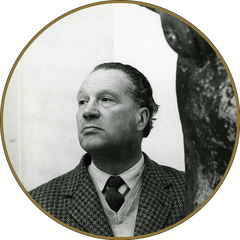Marino Marini biography

Marino Marini, born in Pistoia in 1901, was a versatile Italian artist, known for his sculptural, pictorial, engraving, and lithographic production. From the early years of his career, he showed exceptional talent in art, enrolling in 1917 at the Academy of Fine Arts of Florence. During the academic period, he had the opportunity to attend painting courses held by Galileo Chini and sculpture courses led by Domenico Trentacoste.
In his early years of activity, Marini mainly devoted himself to painting, drawing, and graphics, exploring various artistic techniques. In 1926 he opened a studio in Florence and the following year moved to Milan, at the invitation of Arturo Martini, to teach at the I.S.I.A. in the Villa Reale of Monza. During this period, Marini had the opportunity to come into contact with important artists of the time, including De Pisis, Picasso, Maillol, Lipchitz, Braque and Laurents, who influenced his artistic vision.
In the 1930s, Marino Marini began to gain significant recognition for his work. In 1932 he held his first solo exhibition in Milan and in 1935 won the first prize for sculpture at the Quadriennale of Rome. During this period, his artworks focused mainly on two central themes: the knight and the pomona.
In 1938 he married Mercedes Pedrazzini, whom he affectionately called Marina and who remained by his side throughout his life, supporting him in his artistic career. In 1940 he left teaching in Monza to become a professor of sculpture at the Academy of Brera in Milan, a position he held until 1943, when due to the outbreak of the war he took refuge in Switzerland. During his stay in Switzerland, he had the opportunity to meet internationally renowned artists such as Wotruba, Germaine Richier, Giacometti, Haller and Banninger. He exhibited in various Swiss cities, including Basel, Bern and Zurich.
After the end of the war, in 1945, Marino Marini returned to Milan, reopening his studio and resuming teaching at Brera. From 1948 onwards, he gained increasing international fame. The Venice Biennale dedicated a personal room to him, and during his stay in the United States he had the opportunity to meet artists such as Moore, Arp, Feininger, Calder, Dalì and Tanguy.
His artworks have been exhibited in important cities such as New York, Zurich, Rome and also reached Japan in a major traveling exhibition in 1978. From the 1970s, museum institutions dedicated to the artist began to be founded. In 1973 the Marino Marini Museum was inaugurated in the Civic Gallery of Modern Art of Milan, followed in 1976 by the permanent room dedicated to Marini in the New Pinakothek of Munich. In 1979, in Pistoia, the documentation center of Marino Marini's artwork was inaugurated, which later found its home in the restored Convent of Tau.
Marino Marini died in Viareggio in 1980, leaving behind a significant artistic legacy. In 1988, in Florence, the Marino Marini Museum was inaugurated, thanks to a donation of the artist's artworks to the Tuscan city, which held a special meaning for him. The life and artwork of Marino Marini have been celebrated worldwide, with exhibitions and official recognitions that testify to the importance and influence of this exceptional Italian artist in the artistic landscape of the 20th century. His horses and knights, his pomonas and monumental sculptures continue to fascinate and inspire art lovers around the world, keeping his precious contribution to modern art alive.



